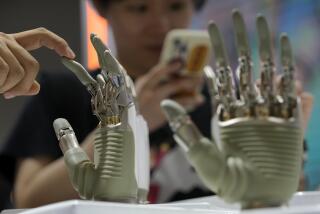When worlds collide
TAKE a seat. No, not that one: Thatâs Bruce Sterlingâs seat. Youâre the consumer. Youâre here because you liked the look of Sterlingâs new book, âShaping Things,â (sleek, in pale shades of green and red, with text in different fonts streaming phrases like âtechnosocial transformation,â âyoung souls,â âdesigners and thinkers.â) On the cover, thereâs a bottle of wine with a bar code where the label should go: two different worlds, two cultures. Bar codes belong to the scary version of the future, wine to the warm and fuzzy past. You live in a world of things that create longing and revulsion at the same time. You donât know if you want the things you want because you want them or because somebody has provoked your desire. Itâs hard to tell anymore if they are bad things -- made by people under duress, bad for the environment and your body -- or good things that fold neatly back into the biosphere when theyâre used up.
So hereâs Bruce Sterling. Weâre going to drink that wine and another bottle. By the time we finish, Sterling -- author, webmaster, designer, father of two daughters, futurist and visionary -- will have pixilated the hell out of that wine: decoding why we buy it, where it comes from, what it means and why it looks the way it does. In the end, it will become desperately clear just exactly how manipulated we are by information that we donât really use to our own advantage, let alone that of the Earth.
âShaping Thingsâ is not a manifesto. Sterling has written manifestos, for the Dead Media Project (which he founded in 1995) and the Viridian Design Movement (which he created in 1996, after his novel on global warming, âHeavy Weather,â appeared). Although his roots are as a journalist, he fled quickly into science fiction with âInvolution Oceanâ (1977), âThe Artificial Kidâ (1980) and âSchismatrixâ(1985). He was among the founding pioneers of âcyberpunk,â but the genre couldnât contain his blend of aestheticism, activism and good old problem-solving.
Then came something Sterling calls âdesign fiction,â a hybrid genre that, he explains, âmakes more sense on the page than science fiction does. Science fiction wants to invoke the grandeur and credibility of science for its own hand-waving hocus-pocus, but design fiction can be more practical, more hands-on.â Several of Sterlingâs books, including âThe Hacker Crackdownâ (1990), a ânonfiction novelâ he distributed in free electronic form and on disk, âHoly Fireâ (1996) and âHeavy Weatherâ (1994) fall squarely in this territory. Design is where Sterling now lives. After years of science fiction, he fell in love with designers and their âlow-key egosâ -- a relief, he suggests, âespecially compared to us authors.â
In âShaping Things,â Sterling divides history into five eras. In the Age of Artifacts, hunters and farmers work with âsimple artificial objects, made by hand, used by hand and powered by muscle.â Around 1500, the Age of Machines emerges, featuring âcomplex, precisely proportioned artifacts with many integral moving parts that have tapped some non-human, non-animal power source.â By World War I, we have entered the Age of Products (âwidely distributed, commercially available objects, anonymously and uniformly manufacturedâ), which is followed by the Age of Gizmos (post-1989), a highly unstable world of end users, or people âlinked to network service providers; they are not stand-alone objects but interfaces.â Finally, there is the Age of Spimes (a Sterling neologism), which is where we live now, adrift in data âdesigned on screens, fabricated by digital means, and precisely tracked through space and time throughout their earthly sojourn.â It sounds more complicated than it is, but Sterling is mapping out a progression, a journey from consumption to control. âTomorrow composts today,â he repeats throughout the book, a phrase that seems dangerously reminiscent of Orwellâs flashing slogans in â1984â but which Sterling uses to remind us that ânew capacities are layered onto older ones.â
âShaping Thingsâ is full of entirely readable large ideas, made palatable by Lorraine Wildâs clean but evocative book design. The whole project exudes a confidence-building, you-too-can-be-an-architect-of-the-future tone, much like the work of Buckminster Fuller, who like Sterling was a practical visionary and often had to create a new language to describe his ideas. Yet unlike Fuller, Sterling doesnât move without making sure you are right there with him. As an example, he uses the bottle of wine to illustrate that what was once an artifact is now a gizmo, complete with access to information. (Remember the bar code?) Each transition âinvolves an expansion of information. It enables a deeper, more intimate, more multiplex interaction between humans and objects.â
In the end, âShaping Thingsâ asks us to consider how we can create a sustainable future, using all the information available to us as consumers, without the preachiness that accompanies the environmental and sustainable lifestyle movements.
Sterling doesnât say so (that would be too cute and patronizing), but he believes in the power of what he calls âtransparent production.â In an age of spimes -- products with websites and bar codes -- we can and will make the right decisions about what to purchase and produce. âThe only sane way out of a technosociety,â he writes, âis through it, into a newer one that knows everything the older one knew, and knows enough new things to dazzle and dominate the denizens of the older order. That means revolutionizing the interplay of human and object. It means bringing more attention and analysis to bear on objects than they have undergone.â
With that in mind, Sterling does not worry about the nefarious uses of radio frequency identification chips -- the technology behind highway E-ZPasses and remote keyless entry -- arguing that they can be used to measure light, airborne pollution, pathogens and pollen counts, creating a world thatâs âauto-Googlingâ all the time. He envisions three kinds of technology that would make our future more sustainable: one that âcan eventually rot and go away all by itselfâ; one built to withstand the passage of time; and âa fully documented, trackable, searchable technologyâ that would, as it reached obsolescence, âhave the grace and power to turn itself in at the gates of the junkyard and suffer itself to be mindfully pulled apart.â
In such a world, humans, who have for generations absorbed industrial effluent -- just as the natural world has absorbed fertilizers and pesticides -- will redesign themselves to have longer, more efficient life spans.
Squeezing these ideas, created on screens, into that dear old artifact, the book, is no easy task, and Sterling is game to take it on. As for the bottle of wine, he asks, â[W]hy did I touch this thing for a few moments and then doom it to an age in a landfill?â Unlike this book, the bottle belongs to that other future, the dark and ugly one.
More to Read
Sign up for our Book Club newsletter
Get the latest news, events and more from the Los Angeles Times Book Club, and help us get L.A. reading and talking.
You may occasionally receive promotional content from the Los Angeles Times.







